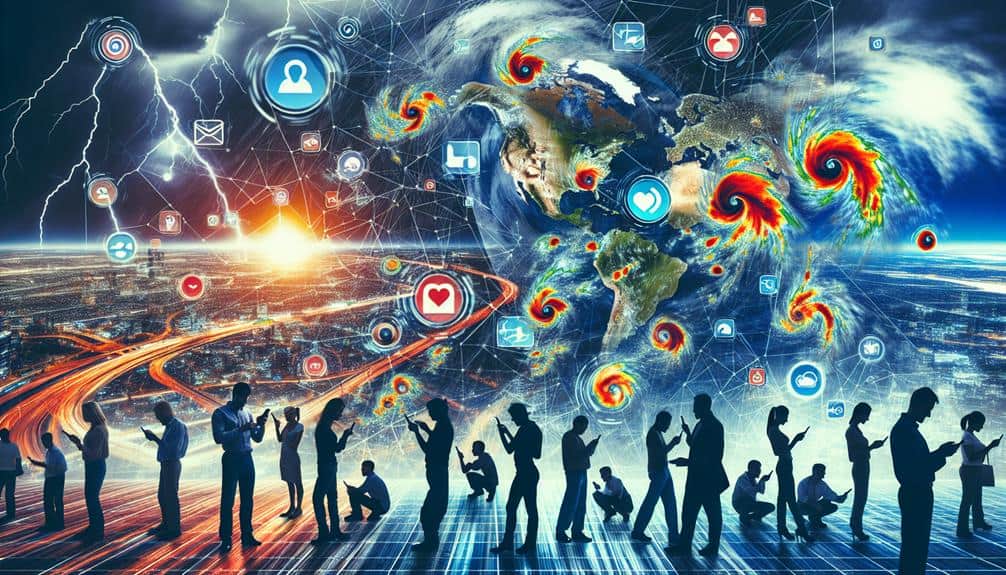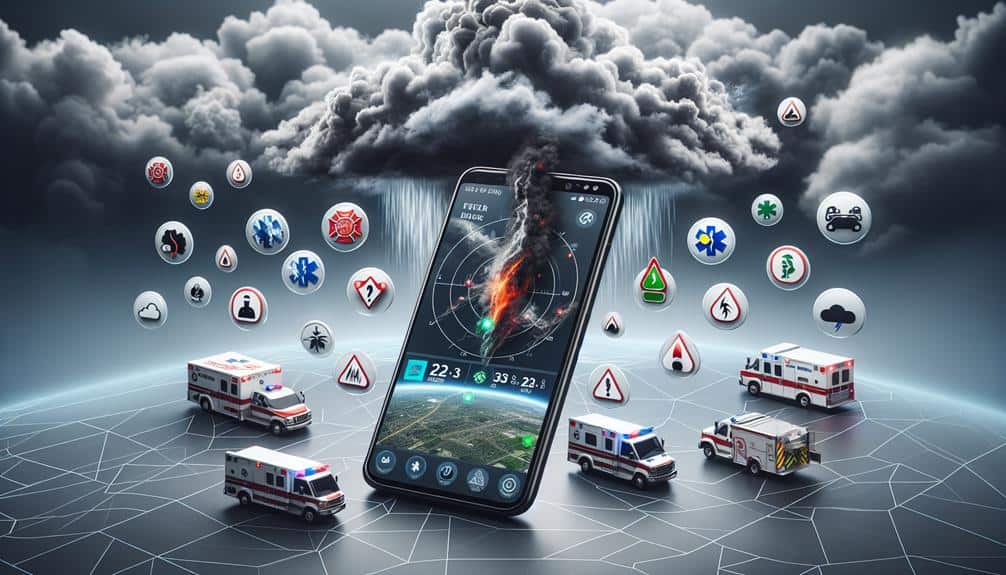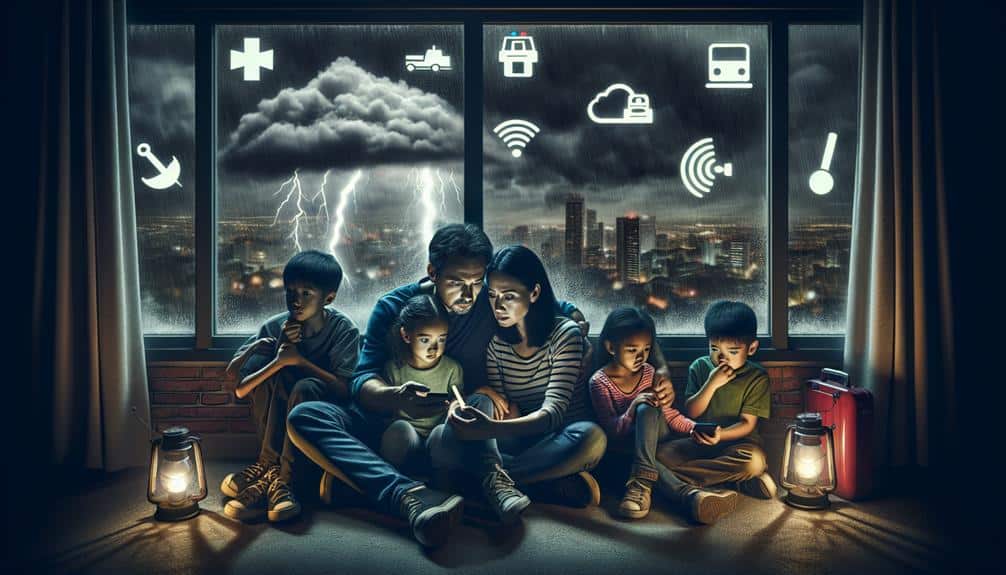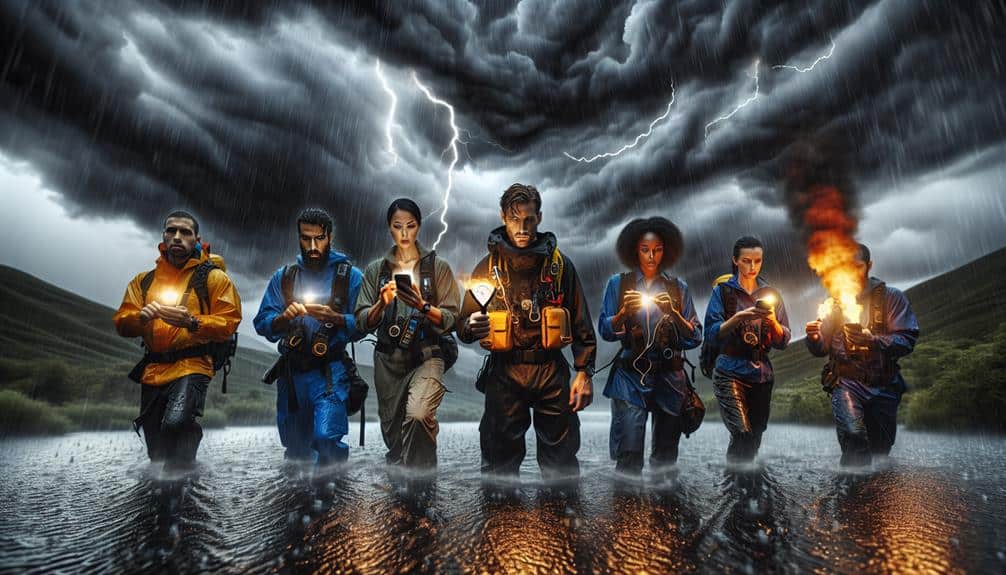In emergencies, quick and effective communication is vital. We should always keep our communication devices charged and program necessary numbers like emergency services and local storm chasers into our phones. Using social media for real-time updates and anticipating weak signal issues with boosters can enhance our readiness. Radios set to local authority channels and emergency apps provide immediate alerts and location sharing. Storm chasers, accessible via social media, offer real-time storm insights. By mastering these tools, we can guarantee we're prepared for any emergency situation. Explore further to understand the full suite of strategies that keep us prepared and informed.
Key Points
- Save emergency services and storm chasers' numbers under recognizable names for quick access.
- Use clear, concise language when contacting emergency services and storm chasers.
- Enable Wi-Fi calling and use signal boosters to maintain communication in weak signal areas.
- Follow local emergency services and storm chasers on social media for real-time updates.
Importance of Timely Communication
Effective communication during emergencies can be the difference between life and death. When we're faced with crises, our ability to relay information quickly and clearly directly impacts response time. We've got to implement strong communication strategies to make sure that every second counts.
First, let's talk about the importance of having predetermined communication plans. We need to know who to contact and how to reach them. Designating a specific person to call emergency services or storm chasers can expedite the process.
Next, using clear and concise language helps eliminate confusion. Saying, “There's a tornado heading towards Main Street, moving east at 30 mph,” is far more effective than vague descriptions.
Another critical aspect is making sure that our communication devices are always charged and accessible. We can't afford to lose precious minutes searching for a phone charger or trying to remember where we last placed our device.
Using Mobile Phones Effectively
When using mobile phones in emergencies, it's important to prioritize signal strength and have emergency contact numbers ready. Weak signals can delay critical communication, so let's make sure we're aware of where to find the best reception.
Additionally, having key numbers saved in our contacts can save precious time.
Signal Strength Matters
How can we guarantee our mobile phones work effectively during emergencies and storms?
First, let's acknowledge that weather conditions can severely impact signal strength. Storms, heavy rain, and strong winds can disrupt the communication infrastructure, making it difficult to reach emergency services or storm chasers when we need them most. To mitigate this, we should invest in signal boosters. These devices amplify weak signals, ensuring that our calls and messages get through even in adverse conditions.
Next, we need to keep our phones charged and carry portable power banks. A dead phone is useless in an emergency. Regularly backing up important contacts and downloading offline maps can also make a significant difference. Additionally, understanding our phone's settings and features—like enabling Wi-Fi calling or using emergency SOS functions—can be life-saving.
Lastly, we should periodically test our phones in different locations to understand where signal is strongest and weakest. This knowledge allows us to make informed decisions about where to seek shelter or call for help during a storm. By taking these proactive steps, we enhance our ability to communicate effectively when it matters most.
Emergency Contact Numbers
As we focus on maximizing our phone's utility, having emergency contact numbers readily accessible is pivotal. In times of distress, quick communication is vital to guarantee a swift emergency response. By organizing our phones effectively, we can make sure help is just a tap away.
To prepare:
- Program emergency services numbers: Save local emergency numbers (911 in the U.S.) under easily recognizable names.
- Add contacts for local storm chasers: They can provide real-time updates and assistance during severe weather.
- Store medical contacts: Include your doctor, nearest hospital, and any specialists you might need.
- Include utility companies: Have the numbers for power, gas, and water companies in case of outages or leaks.
Leveraging Social Media Platforms

We can harness social media platforms to receive real-time updates during emergencies.
By using hashtags, we quickly aggregate critical information and connect with others in our area.
Direct messaging allows us to communicate instantly with storm chasers and emergency services for timely assistance.
Real-time Updates
Leveraging social media platforms, we can get real-time updates from emergency services and storm chasers to stay informed and safe during severe weather events. These platforms provide vital information that enhances our weather monitoring efforts and keeps us in the loop with community alerts. By following the right accounts and channels, we gain instant access to updates that can make all the difference.
Here's how we can use social media effectively:
- Follow local emergency services: Police, fire departments, and weather agencies often post real-time updates.
- Track storm chasers: These experts provide firsthand reports and visuals from the field.
- Join community groups: Local groups on platforms like Facebook can offer timely alerts and shared experiences.
- Enable notifications: Turn on alerts for severe weather updates to stay informed instantly.
Hashtag Utilization
To amplify our real-time updates, let's explore the power of hashtag utilization on social media platforms. Hashtags enable us to tap into larger conversations, making our posts discoverable to a broader audience. By staying current with hashtag trends, we can guarantee our posts are seen by those who need the information most and those who can provide important assistance.
We should initiate targeted hashtag campaigns to focus attention on specific weather events or emergencies. By creating and using unique, relevant hashtags, we heighten our online engagement and foster a community of informed and proactive individuals. For example, if a storm is approaching, hashtags like #StormAlert or #SafetyFirst can quickly disseminate vital updates.
It's necessary to monitor and adapt to hashtag trends as they evolve. This flexibility ensures that our messages remain relevant and reach the intended audience. Social media platforms like Twitter, Instagram, and Facebook are invaluable for this purpose, allowing us to spread real-time information swiftly and efficiently.
Direct Messaging
Utilizing direct messaging on social media platforms allows us to deliver important updates swiftly and personally to those in need. This method guarantees that information reaches its intended recipients without delay. Whether it's notifying emergency services or storm chasers, in-app messaging is a crucial tool when immediate action is required.
With direct messaging, we can:
- Send personalized emergency alerts to individuals in affected areas.
- Coordinate with storm chasers for real-time reporting and updates.
- Inform emergency services of urgent situations with precise locations.
- Receive instant feedback from recipients, ensuring messages are acknowledged.
By leveraging these platforms, we harness the power of direct communication to maintain safety and preparedness. The immediacy and personal touch of in-app messaging make it an essential resource in crisis management.
Moreover, the ability to reach out directly means we can bypass potential delays associated with other forms of communication. This guarantees that our emergency alerts and updates are both timely and effective.
In a world where every second counts, direct messaging on social media platforms is a game-changer, providing us with the freedom to act swiftly and decisively.
Radio Frequencies and Protocols
When contacting emergency services and storm chasers, it's essential we use the correct radio frequencies and follow established protocols. Missteps can lead to radio frequency interference, which hampers communication and delays emergency response times. To make sure our messages get through clearly and promptly, we must familiarize ourselves with the designated frequencies for emergency communication and storm chasing activities.
First, let's verify our radios are set to the appropriate channels. For emergency services, these are often outlined by local authorities and vary depending on the region. We must avoid any non-essential chatter on these frequencies to keep them clear for critical information.
Equally important, storm chasers often use specific frequencies to share real-time updates and weather observations. By monitoring these channels, we can stay informed and contribute valuable data without causing disruptions.
Adhering to radio protocols is just as essential. We should always begin transmissions with a clear identification of our call sign and location. Use concise, precise language to convey essential information. Remember, every second counts in emergencies, and clarity can have a significant impact on response times.
Emergency Apps and Services

Emergency apps and services provide essential tools for swiftly connecting with first responders and staying informed during critical situations. These apps can be life-saving, offering features like real-time emergency alerts and notifications. They help us stay ahead of any potential danger and allow us to act quickly and efficiently.
In today's world, having these tools on our smartphones gives us a sense of freedom and security.
Here are some key features to look for in emergency apps:
- Real-time emergency alerts: Immediate notifications about severe weather, natural disasters, or other emergencies.
- Location sharing: Easily share your location with family, friends, or emergency personnel to make sure you're found quickly.
- Tracking capabilities: Keep track of your loved ones during emergencies, providing peace of mind and coordination.
- Two-way communication: Directly communicate with first responders, ensuring your needs are addressed promptly.
Direct Contact With Storm Chasers
Connecting with storm chasers can provide us with up-to-the-minute, on-the-ground insights during severe weather situations. These brave individuals often have firsthand information that can be essential for our safety. However, reaching out to them effectively requires sound communication strategies and an understanding of safety tips.
First, we should identify reliable storm chasers through social media platforms like Twitter or Facebook. Verified accounts and those with substantial followings are generally more trustworthy. When contacting them, clear and concise messages work best. We might say, 'I'm in [location], can you provide updates on the storm's path?' This guarantees we get precise information quickly.
Safety tips are vital when engaging with storm chasers. We must remember that these professionals are trained to handle extreme weather and that mimicking their actions without proper knowledge is dangerous. Instead, we should use their information to make informed decisions while staying safe indoors.
Another key communication strategy is to follow storm chasers who livestream their pursuits. This real-time footage can be invaluable but should never entice us to venture out. By combining their insights with our situational awareness, we can navigate severe weather more safely.
Frequently Asked Questions
What Should I Include in My Emergency Kit for Storm Situations?
When prepping for storms, let's juxtapose freedom and readiness: pack emergency supplies like water, food, and first aid. Include shelter options such as tarps and blankets. Stay ready, stay safe, and stay free.
How Can I Stay Informed About Changing Weather Conditions While Traveling?
To stay informed about changing weather conditions while traveling, we should use weather apps for real-time notifications and listen to local radio for updates. These tools guarantee we remain aware and can adapt our plans quickly.
Are There Specific Training Programs for Aspiring Storm Chasers?
Ever wondered how to master storm chasing techniques? There are indeed specific training programs designed for aspiring storm chasers. They teach essential skills and safety precautions, ensuring we're prepared to handle the thrilling unpredictability of nature.
What Are the Signs That Indicate a Storm Is Approaching?
We can spot signs of an approaching storm by watching darkening skies, feeling sudden temperature drops, and hearing distant thunder. Effective storm preparation includes monitoring weather alerts and staying informed to maintain our safety and freedom.
How Can I Safely Document Storm Activity Without Putting Myself at Risk?
We can safely document storm activity by conducting a thorough risk assessment and implementing strict safety precautions. Always stay informed, use proper equipment, maintain a safe distance, and never prioritize footage over personal safety.


